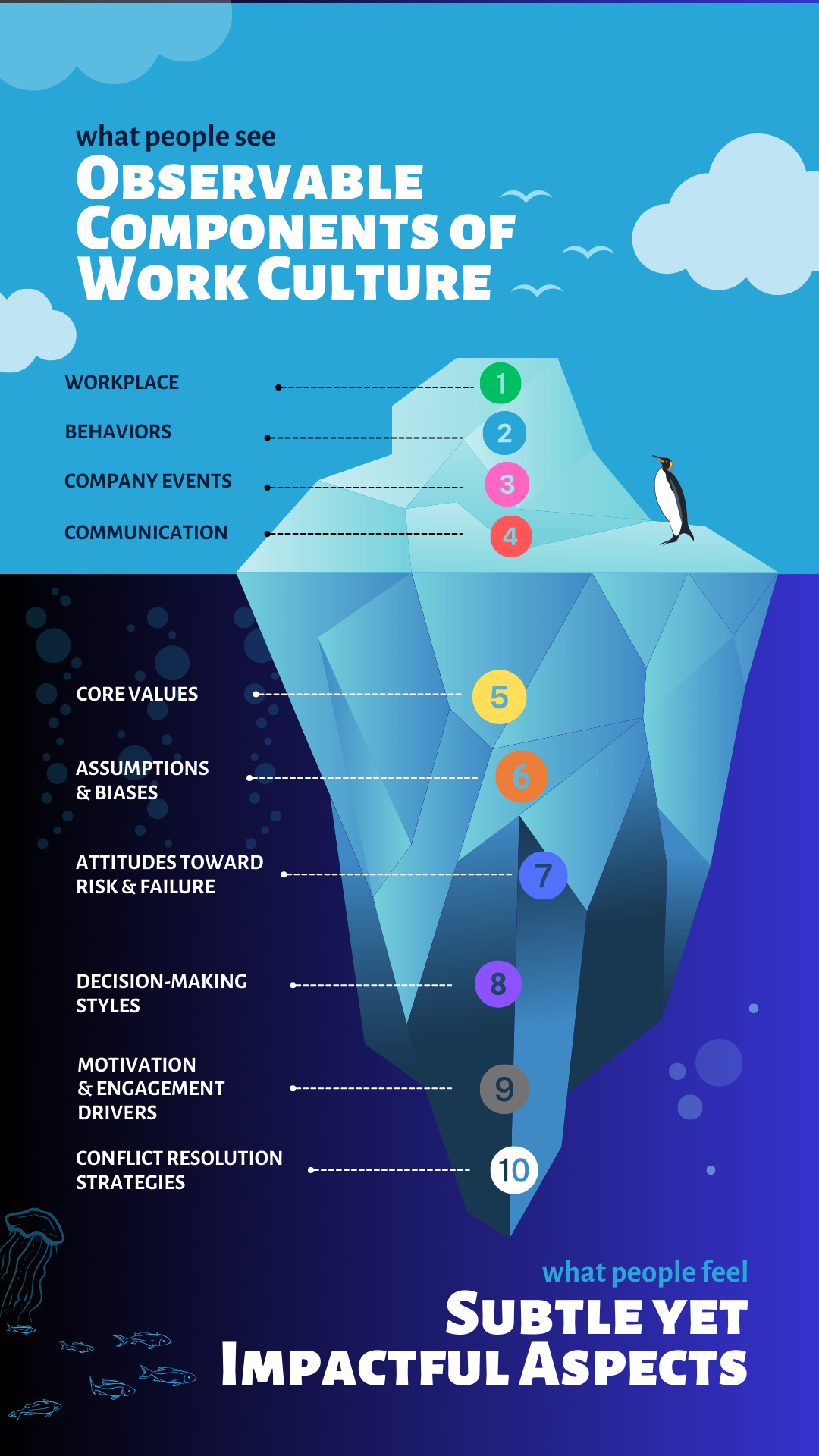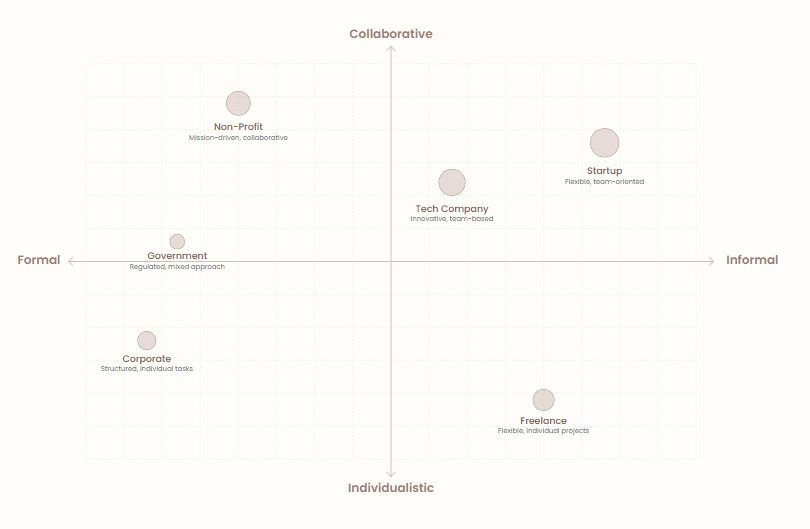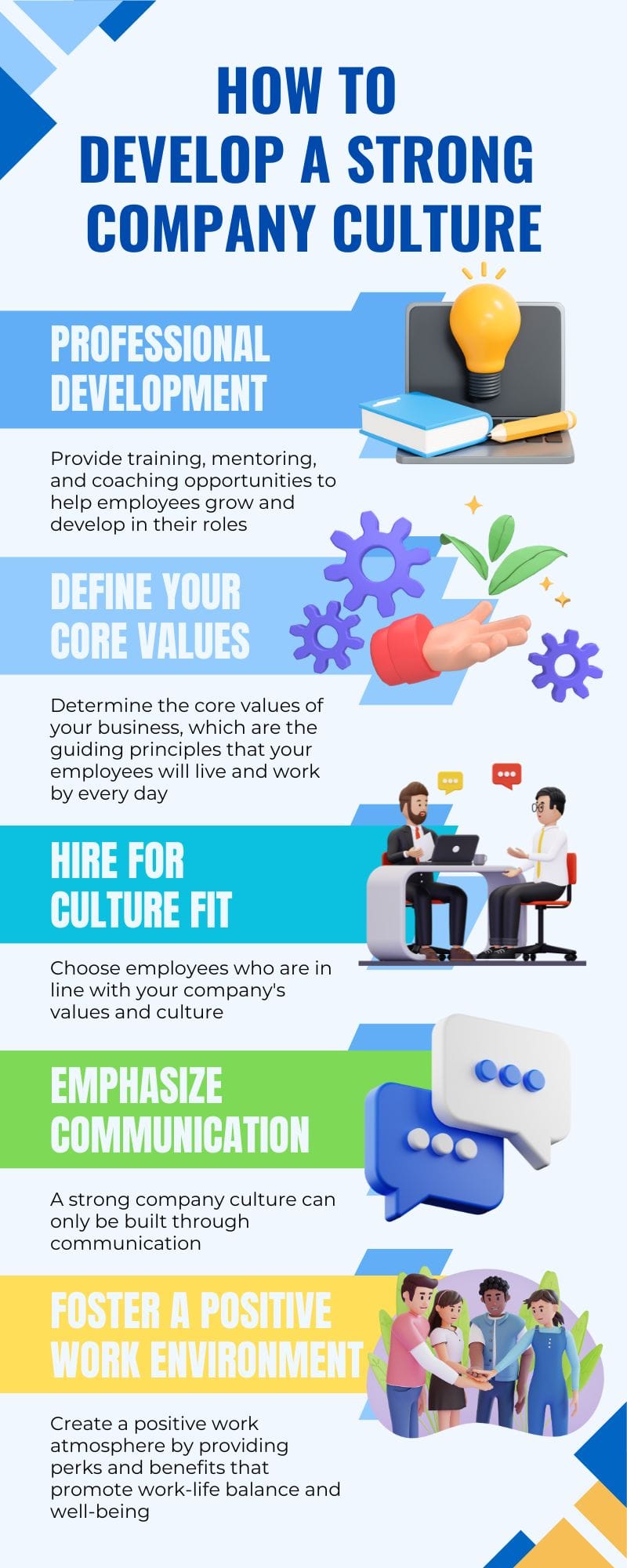Examples of Work Culture: Types, Elements, and Best Practices
Learn about different types of work culture, key elements that create a positive environment, and real-life examples of companies with outstanding workplace cultures.

Why do some workplaces run smoothly while others are plagued by chaos and conflict? The answer often lies in the company's work culture.
Negative work culture can indeed have severe consequences for a business. Here are two notable examples.
❌Enron: Known for its toxic, cutthroat work environment, Enron's internal culture promoted unethical behavior and dishonesty, leading to its eventual collapse and one of the most notorious corporate scandals in history.
❌Uber: In 2017, Uber's negative work culture came under intense scrutiny following allegations of sexism and discrimination. This, combined with other shocks, damaged the company's reputation and contributed to CEO Travis Kalanick's resignation.

Work Culture Definition and Why It Is Important
A company's culture is the foundation for future innovation. An entrepreneur's job is to build the foundation. – Brian Chesky
What is Work Culture?
Work culture refers to the collective values, principles, and behaviors that define the social and professional environment of a company.
This encompasses:
- the shared beliefs
- norms
- practices.
These 3 factors shape employee conduct, performance, and work ethic.
In essence, work culture sets the tone for how things get done within an organization.

Observable Elements of Work Culture
Workplace: The physical environment of a workplace, including its layout, design, and amenities, offers visible cues about an organization's priorities, attitudes toward employees, and commitment to collaboration, innovation, comfort, and sustainability.
Behaviors: They refer to how employees engage with one another, their supervisors, and clients, reflecting practices within an organizational setting.
Company events: The nature of corporate-sponsored or attended functions can serve as valuable insights into a company's cultural identity. For example, a strong inclination towards after-work gatherings suggests a relaxed and convivial atmosphere.
Communication: How knowledge is disseminated throughout an enterprise can provide significant clues regarding its prevailing ethos. Firms prioritizing transparency generally foster unrestricted dialogue, whereas those embracing a rigid hierarchy typically impose stricter controls over information flow.
Unseen Elements of Work Culture
Core values: Foundational beliefs represent the essential tenets and philosophies anchoring organizational behavior. Such guiding principles tend to feature prominently across official documentation and promotional content.
Assumptions & biases: The unspoken opinions and perspectives that employees harbor regarding themselves, their coworkers, and their jobs.
Attitudes toward risk & failure: The level of comfort experienced by workers when it comes to experimenting with new ideas and learning from errors.
Decision-making styles: The protocols followed by organizations when making choices, ranging from top-down orders issued by management to collective brainstorming among team members.
Motivation & engagement drivers: The aspects that inspire and retain employee interest in their tasks and roles.
Conflict resolution strategies: Ideally, they provide a framework for addressing and resolving disagreements constructively, fostering a positive work environment.

Types of Workplace Culture and Great Examples
...the sea of culture is vast – Ian Bogost

Formal Work Culture
Law firms, financial institutions, and government agencies
🔉Communication: Follows a clear hierarchy. Information flows through designated channels, often with written documentation.
👔Dress code: Professional attire expected.
🤝Meetings: Pre-planned with agendas and minutes.
🌍Decision-making: Top-down approach with clear approval processes.
💼Workstyle: Independent with a focus on individual accountability.
Informal Work Culture
Startups, creative agencies, and nonprofits
🔉Communication: Open and casual. Information flows freely through various channels, including verbal communication.
👔Dress code: Relaxed and comfortable attire.
🤝Meetings: Can be impromptu and focus on brainstorming.
🌍Decision-making: Collaborative with input from various levels.
💼Workstyle: Flexible and adaptable, encouraging interaction and teamwork.
Collaborative Work Culture
Design studios, marketing departments, or software development teams within companies
🔉Communication: Open and transparent. Emphasis on information sharing and feedback.
👔Dress code: Varies, but often leans towards comfort for easy interaction.
🤝Meetings: Frequent and focused on teamwork and problem-solving.
🌍Decision-making: Consensus-driven with a strong emphasis on group input.
💼 Workstyle: Team-based, where individual contributions come together for a common goal.
Mission-driven Work Culture
Nonprofit organizations, educational institutions, and socially responsible businesses
🔉Communication: Focused on the company's mission and vision. Regular updates and reminders about the company's purpose.
👔Dress code: Can vary, but often reflects the company's values and industry.
🤝Meetings: Regularly assess progress towards the company's mission.
🌍Decision-making: Aligned with the company's mission and long-term goals.
💼Workstyle: Goal-oriented and passionate, with individuals motivated by the company's purpose.
Innovative Work Culture
Big Tech
🔉Communication: Open and encourages new ideas. Brainstorming sessions and open forums for discussion are common.
👔Dress code: Often casual to foster a creative environment.
🤝Meetings: May be less structured, allowing for free-flowing ideas.
🌍Decision-making: Encourages calculated risks and experimentation.
💼Workstyle: Creative and independent, with a focus on finding new solutions and approaches.
Team-oriented Work Culture
Sports teams, design studios, and software development companies
🔉Communication: Frequent and emphasizes clear roles and responsibilities within the team.
👔Dress code: Can vary, but prioritizes comfort for collaboration.
🤝Meetings: Regular team meetings and collaboration sessions are crucial.
🌍Decision-making: Collaborative with a focus on achieving team goals.
💼Workstyle: Relies heavily on teamwork, with individuals playing a specific role within the team's success.
Structured Work Culture
Healthcare providers, manufacturing firms, or engineering consultancies
🔉Communication: Follows clear processes and procedures. Documentation is essential.
👔Dress code: Can vary, but there might be some level of formality expected.
🤝Meetings: Well-defined agendas and expected outcomes.
🌍Decision-making: Follows established processes and approval chains.
💼Workstyle: Defined roles and responsibilities with clear expectations and deadlines.
Individualistic Work Culture
Sales, real estate, or consulting
🔉Communication: Clear and concise, but may not be as open as in collaborative cultures. Focus often lies on individual performance.
👔Dress code: Can vary, but may prioritize professionalism or client-facing appearances.
🤝Meetings: May be less frequent and focused on specific needs or tasks.
🌍Decision-making: Empowers individuals to make decisions within their area of expertise.
💼Workstyle: Independent and self-driven, with a focus on individual goals and achievements.
The Impact of Work Culture
Work culture plays a pivotal role in shaping the overall performance and success of a business, as well as the well-being and satisfaction of its employees.
A negative work environment hinders creativity, collaboration, and learning, making it difficult for the company to adapt to changing market conditions and stay competitive.
On the flip side, creating a positive work culture leads to:
- increased productivity
- better employee morale
- improved communication
- reduced turnover rates
- greater profitability of the business.
However, building a harmonious work environment takes effort and deliberate action from all members of an organization.
Examples of Successful Work Cultures
Below, we will explore thriving work environments that promote harmony and collaboration.
Patagonia
A Leader in Environmental Activism and Social Responsibility
Patagonia is a brand known not only for its high-quality outdoor clothing and gear but also for its unwavering commitment to environmental activism and social responsibility.
The company's values are centered around building the best possible products while causing minimal harm to the environment and using their platform to inspire and implement solutions to the global environmental crisis.
Ben & Jerry's
Champions of Social Justice and Progressive Causes
This iconic ice cream company prides itself on practicing "Vermonty Business Practices," which encompass social responsibility and environmental stewardship.
Through innovative campaigns and collaborations with various advocacy groups, Ben & Jerry's consistently demonstrates that they are more than just an indulgent treat—they are a force for good.
Tesla
Pioneering Sustainable Energy Solutions
Tesla delivers stylish and efficient vehicles that contribute significantly to reducing greenhouse gas emissions.
Founded by visionary entrepreneur Elon Musk, this cutting-edge electric vehicle manufacturer continues to push boundaries and reshape the automotive industry through advanced technology and eco-friendly designs.
Whole Foods Market
Promoting Healthy Living and Quality Products
Embodying the philosophy of "Whole Body, Whole Planet, Whole Paycheck," the company remains dedicated to offering top-notch products, protecting the planet, and ensuring fair prices for all involved parties.
As such, shoppers can trust Whole Foods Market to provide them with quality goods that align with their wellness goals and environmental values.
IBM
Building Long-Term Client Relationships and Ethical Conduct
With core values including "Client Success, Innovation & Trust, and Citizenship," this tech giant shows that success goes beyond financial gains; instead, focusing on creating lasting impacts through responsible practices and groundbreaking innovations.
Encouraging Creativity, Collaboration, and Employee Development
Famous for its innovative and creative approach to work, Google nurtures a thriving workplace ecosystem through collaboration, continuous learning opportunities, and cultivating an environment where employees feel encouraged to experiment and grow personally and professionally.
Salesforce
Prioritizing Customer Success Above All Else
Built upon a solid base of value centering around "Customer Success," the company ensures that every interaction between employee and user results in meaningful experiences and mutually beneficial outcomes.
Spotify
Fostering Experimentation, Autonomy, and Teamwork
Spotify empowers its workers to think creatively when solving problems or implementing novel concepts. Offering ample freedom within structured frameworks allows teams across departments to flourish independently while maintaining alignment with overall organizational objectives.
Zappos
Delivering WOW Through Unparalleled Service and Company Culture
Focused on creating memorable interactions through personalized assistance and genuine care, Zappos successfully differentiates itself from competitors and maintains loyal supporters who appreciate the company's sincere efforts.
Adobe
Investing Heavily in Staff Training and Professional Growth
Committed to ongoing improvement, Adobe invests heavily in training programs and professional development initiatives aimed at enhancing employee skills and knowledge, which reflects the organization's dedication to staying ahead of the curve.
Atlassian
Nurturing Open Communication and Collective Problem Solving
Atlassian embodies a vibrant and supportive workplace culture built upon transparency and cooperation. Leveraging diverse perspectives enables cross-functional teams to tackle complex challenges effectively, ultimately driving greater success for the entire enterprise.
How Company Slogan Can Reflect Its Values
Apple: "Think Different." Focus on creativity, innovation, challenging the status quo, and individualism.
Salesforce: "Helping customers succeed. It's a Salesforce thing." A reflection of a collaborative and team-oriented culture where employees work together for success.
Netflix: "See what's next." Focus on originality and trust.
Google: "Do the right thing." Ethical and purpose-driven culture alongside financial success.
Buffer: "Done well today is better than done perfectly next week." Highlights their emphasis on consistent progress and productivity over unrealistic perfectionism.
Harley Davidson: "Live to Ride, Ride to Live." Focus on freedom, passion, community, and independence.
GitLab: "Better teams. Faster progress. Better world." Commitment to improving collaboration, accelerating development, and making a positive impact on the global community through efficient software development practices.
LEGO Group: "Only the best is good enough." A culture that fosters creativity, innovation, and a sense of purpose that extends beyond just toys.
Whether you are part of a small startup or a large corporation, these examples of great job culture serve as valuable inspiration for building a thriving organizational culture.
How to Build a Strong Work Culture
11 Secrets to a Positive Work Culture
- Effective Communication
Establish open and transparent communication channels, ensure regular updates and feedback loops, and encourage active listening and constructive dialogue.
- Shared Values and Vision
First identify what makes your organization unique by examining factors such as history, mission, industry, competitors, and stakeholder needs. Then gather input from diverse sources, refine the resulting list of candidate values, test them with key stakeholders, launch the chosen values, and integrate them thoroughly into all aspects of organizational practice.
- Supportive Leadership
To foster a strong work culture, prioritize being an approachable, empathetic, and supportive leader, actively encourage employee development and growth, and consistently recognize and appreciate your employees' contributions.

- Opportunities for Professional Growth
Ensure access to training and development programs, provide clear career progression paths, and support continuous learning and skill enhancement for your employees.
- Work-Life Balance
Consider offering flexible working hours and the option for remote work, promoting regular breaks and vacation time, and implementing policies that prioritize the personal well-being and family life of your employees.

- Employee Recognition and Rewards
Be sure to regularly acknowledge accomplishments and dedication, implement fair and significant rewards, and celebrate important milestones and victories.
- Inclusive and Diverse Environment
Prioritize diversity and inclusion at every level, respect and value different perspectives and experiences, and take proactive steps to identify and address discrimination and biases within your organization.
- Collaboration and Teamwork
Encourage teamwork and collaborative projects, create regular opportunities for team-building activities, and foster a sense of community and belonging among your employees.
- Employee Empowerment
Consider trusting your employees with autonomy and decision-making power, encouraging innovation and creative problem-solving, and providing them with the necessary resources and support to help them succeed.
- Positive Reinforcement
Make sure to use positive feedback to motivate and inspire your team, offer constructive criticism focused on growth and improvement, and take the time to celebrate even the smallest wins and progress along the way.
- Healthy Work Environment
Ensure your team has access to a safe and comfortable physical workspace, wellness programs, and mental health support, and promote healthy habits and work practices.

How long does it take to build a positive work culture?
Defining Values & Priorities
⏳3-6 months
- Clearly stating key values that reflect your brand and company strategy.
- Engaging employees in the value determination process.
Implementation & Communication
⏳6-12 months
- Developing and implementing policies, procedures, and practices that support defined values.
- Effectively communicating the new corporate culture at all levels of the organization.
- Demonstrate leadership by showing commitment to new cultural initiatives.
Continuous Support & Improvement
⏳1-2 years
- Regularly assessing and adjusting cultural initiatives based on feedback.
- Continual learning, encouragement, and recognition of employees.
- Integrating cultural values into all aspects of talent management.
Overall, building a sustainable workplace culture may take 1 to 3 years depending on the size and complexity of the organization. The keys are consistent attention, persistence, and engagement from all levels of management.
Is there a difference between remote and traditional work culture?
Remote and traditional work cultures have distinct characteristics:
- Communication: Face-to-face vs. online (video calls, chats)
- Management: Attendance-focused vs. productivity & self-management
- Identity: Office-space bonding vs. establishing virtual connections
- Balance: Separated workspaces vs. blended environments
- Trust: Presence-driven evaluation vs. mutually developed trust and result-orientation.
To effectively manage the differences between remote and traditional work, employers and employees must consider the consequences of each factor.
Tools for Developing Strong Work Culture
To foster a strong company culture, especially when employees work remotely, businesses utilize a variety of digital platforms and applications.
Communication Tools
- Video conferencing platforms (Zoom, Microsoft Teams, Google Meet)
- Messengers and chats (Slack, Microsoft Teams, WhatsApp Business)
Collaboration Tools
- Cloud platforms for documents and projects (Google Workspace, Microsoft 365)
- Task management tools (Trello, Asana, JIRA)
- Virtual whiteboards (Miro, Mural)
Event Platforms
- Virtual rooms for events (Hopin, Brazen)
- Gamification tools (Kahoot, Quizizz, Mentimeter)
- Learning platforms (Coursera, Udemy, LinkedIn Learning)

Engagement and Recognition Tools
- Reward management systems (Bonusly, Workhuman)
- Continuous feedback platforms (Beamer, Survey Monkey)
Analytical Tools
- HR assistant platforms &Employee data analysis (Bamboo HR, TMetric)
- Corporate culture assessment tools (HRBrain, Glassdoor)
How Automated Time Tracking with TMetric Improves Business Culture
TMetric helps increase transparency and accountability
- Objective measurement of productivity and use of time
- Possibility to detect needs for reallocation of workload
Employees get access to advanced planning, which mitigates risks of mismanagement
- PTO management at the fingertips
- Comprehensive scheduling and monitoring of work hours
Build a positive work environment and promote work life balance in a click
- Identification of excessive overtime and prevention of burnout
- Support for flexible work schedules and remote employment.


